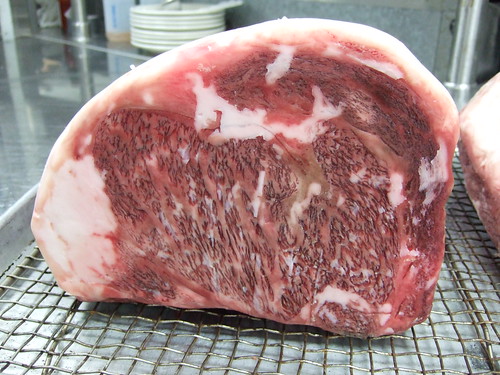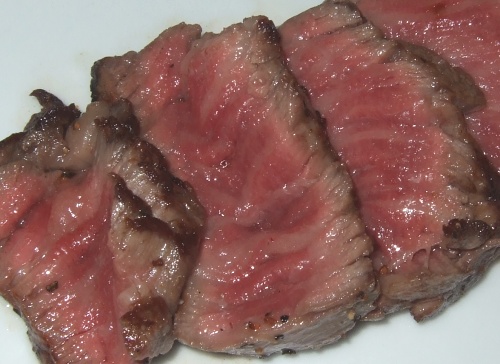Kobe beef probably isn't what you think it is. The term "Kobe beef" gets thrown around alot — you see it on some high-end steak house menus in Houston, and more ubiquitously on burger joint menus as a "Kobe burger."
There's a certain mystique about Kobe beef, vaguely associated with fat, docile cows from Japan that get massaged with sake and force-fed beer through a tube. Though it's sometimes hard to separate hype from reality — the steak from the sizzle if you will — one thing's for sure: real Kobe beef is very hard to come by.
Carlos Rodriguez knows this. He's the Concept Chef (i.e. head honcho) at Vic & Anthony's in downtown Houston. He's spent the last three years trying to source the real Kobe beef to serve here in Houston. Problem is, what limited supply there is gets shipped to cities like New York, Los Angeles, Chicago, and Las Vegas. Recently, he was able to work through a broker in New Jersey to have the Kobe beef shipped directly from Japan. This past Friday he started serving a five ounce tenderloin of real Kobe beef for an admittedly eye-popping $130.
Read More...Why so expensive? First let's establish what Kobe beef is and isn't. Kobe beef is a cut of meat from the Tajima breed of Wagyu cattle that is raised and slaughtered in the Hyogo Prefecture of Japan (the city of Kobe being the capital). The traditions associated with raising cattle in this area of Japan — including feeding the cows beer and massaging them with sake — are supposedly ideal for producing the highest quality beef from Wagyu cattle (the breed itself is genetically predisposed to producing highly marbled beef). It's this intensive process combined with limited production that makes real Kobe beef scarce, and therefore expensive.
Most of the Kobe beef listed on restaurant menus is actually from Wagyu cattle that were imported to the US and then cross-bred with Angus cattle. Officially, this type of beef is supposed to be labeled as "Kobe-style,"American Kobe," or "American Wagyu." Unfortunately, most restaurants do not make the distinction and incorrectly label their beef as Kobe, either through ignorance or willful misrepresentation.
The Kobe beef at Vic & Anthony's is the real deal. As per the Japan Meat Grading Association, this beef is graded as A5 Kobe beef, the highest grade based mainly on the density of marbling. Rodriguez is currently offering the previously mentioned five ounce tenderloin, and is in the process of dry-aging several large cuts of strip loin. The tenderloins should be available for at least another 10 days, with the strips being offered some time in the next week. The strip steaks will be available in about the same portion size and price.
On a recent Tuesday night, myself and a group of fellow steak lovers descended on Vic & Anthony's for a Kobe beef taste test. We ordered two A5 Kobe tenderloins and two USDA prime tenderloins, both cooked medium-rare. The differences were striking. Texture-wise, the Kobe beef is buttery and velvety, and exceedingly tender. Obviously, the traditional USDA prime tenderloin is tender but much firmer. But the real difference is in the flavor. The only way I can describe the Kobe is to say that this is what beef might taste like if a scientist decided to "perfect" the flavor of beef. The beef flavor is exceedingly refined and concentrated. Due to the marbling and medium-rare preparation, the beef almost melts in your mouth.
Although Rodriguez hopes to offer A5 Kobe beef as a regular menu item in the future, he is currently just testing the waters to see what kind of demand there might be in Houston. For any serious steak lover in Houston, a trip to Vic & Anthony's to try this rare delicacy is a must (for tasting purposes, you can split a portion among 2-3 people to help with the cost). Plus you'll be supporting and acknowledging Chef Rodriguez's prodigious efforts to bring A5 Kobe beef to Houston steak lovers.







7 comments:
Someday... someday.
@GunsandTacos - do what we did, get a group of folks together and split one. Keeps the cost down and you can at least get the experience.
We did a similar side x side last night. The kobe was amazing, but I decided that for me personally, it probably wasn't worth the cost for a full serving. I was really happy to have had the chance to try it though - very different!
I love the shots of the raw beef. Really highlights what you're getting.
Sounded outstanding.
Some of your comments are not accurate. Tajima is only one line of Wagyu, their are three others.
Wagyu means Japanese Cow. Japanese coman black cattle lines are Tajima, Totori, Kadaka and Shimani , all of which can be KOBE Beef. Japanese rarely massage or feed beer, mostly for touring vacationers only . Their are approx 4,000+ fullblood wagyu in the US( They came here from Japan) KOBE beef is from Japan ( Because KOBE is a location in Japan), but wagyu beef, which can be the same, can be from the USA. A5 is not the highest grade on the Japanese scale. You need to do your homework
and not draw quick conclusions.Many of the American raised wagyu beef excede this grade. HoweverI am sure the Japanese breeders appreciate your naive endorsement. You should Go to the American Wagyu Association website, contact some american breeders and do your homework
Ken
Sutton Creek Cattle Company
Shut up ken. Let the man have his blog.
You should copyright that photo.
I bet it will be *borrowed* extensively.
It's good to know that Kobe is widely imitated. I wonder how many have dropped $100 on something that wasn't the real deal, and ended up with a "meh" impression.
Kobe is for the egotist without a budget.
It's kinda like wine. Let's see I can get a fantastic Prime tenderloin for $35-40, or a smaller piece of "Kobe" tenderloin for $130 (three to four times the price) is it 3 to 4 times as good??? Easy answer: "NO." Is a bottle of Jordan is good as a bottle of Nickel & Nickel? "NO" Is the Nickel & Nickel 5 times better than the Jordan, "NO." Bottom line is: Would you rather go out once and have "Kobe and Nickel & Nickel" -OR- go out 4 or 5 times and have Prime and Jordan? If you're a multi-millionaire, you needed answer the question, but for us in "upper-middle income bracket the answer is easy.
With limited supply the price is elastic and will continue to rise above the value, that's why American Breeders can produce beef as good as "Kobe" but without the sanction of the "Kobe" label. Eat Prime or Wagyu and keep your money from the profit margin of the Japanese.
Post a Comment